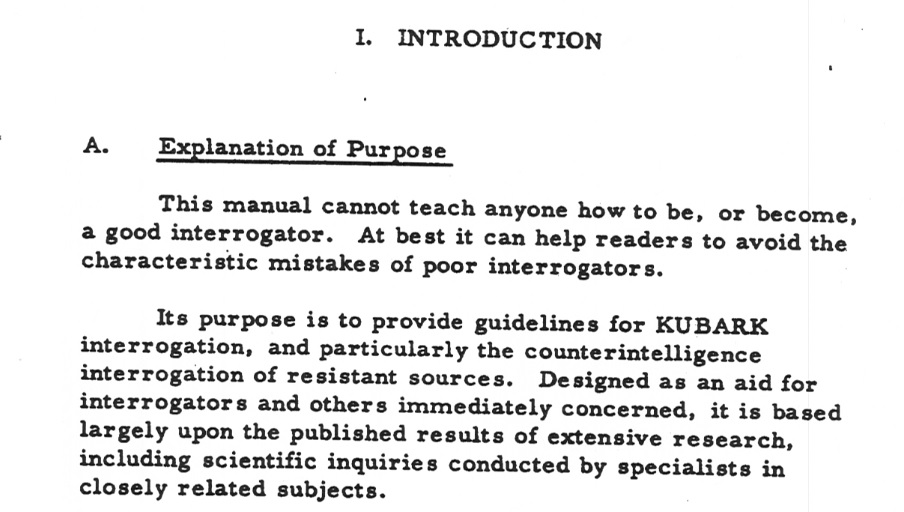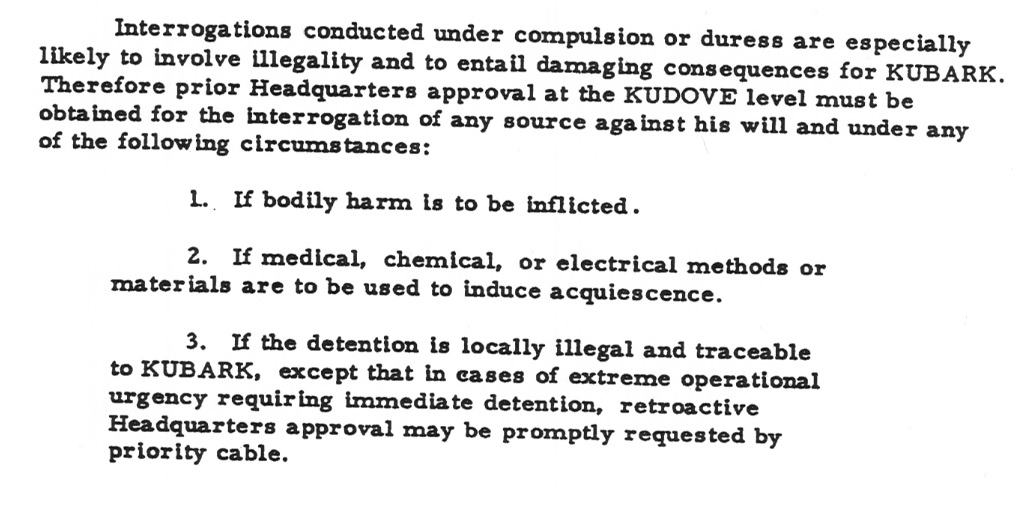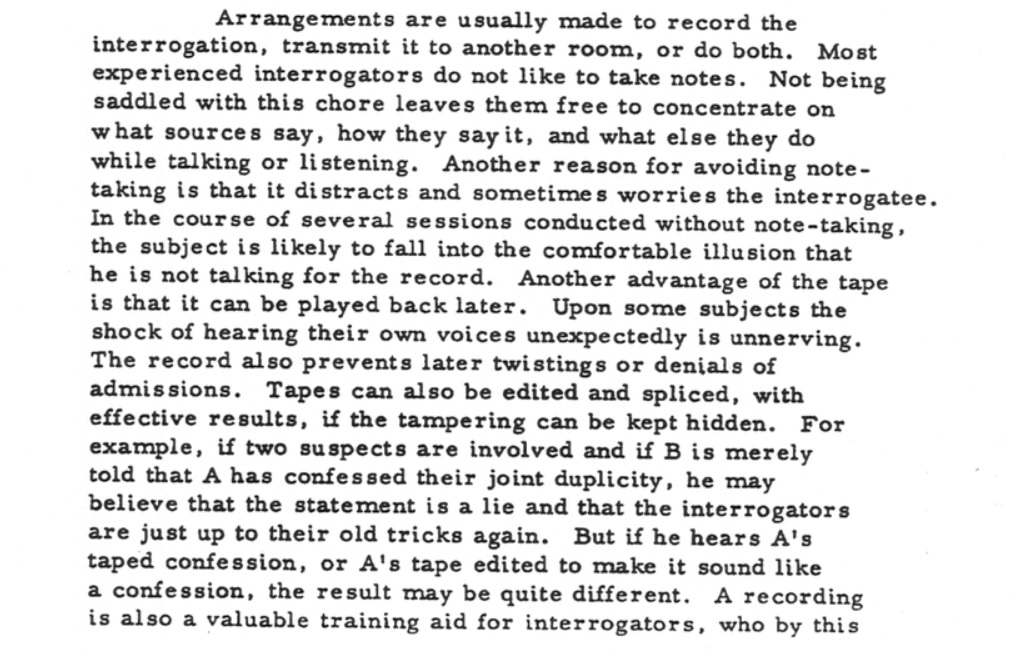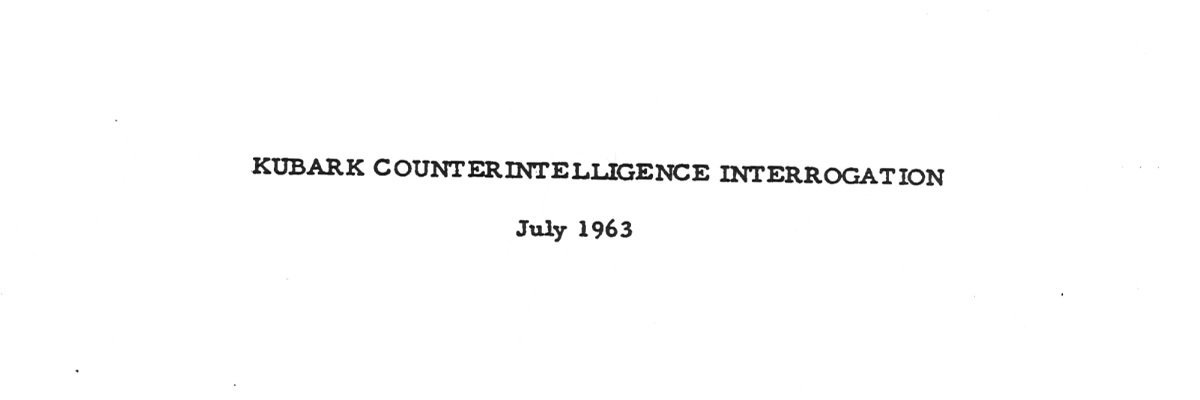In the midst of controversy over the potential release of the Senate Select Committee on Intelligence report on the CIA’s “enhanced interrogation” program, last month the CIA quietly released a newly declassified version of the infamous 1963 “KUBARK” interrogation manual. (Note: “KUBARK” was the CIA’s code name for itself.)
The new material adds greatly to our understanding of the CIA’s interrogation and torture history. This manual was first released to the Baltimore Sun in 1997 with heavy redactions, and received considerable coverage at the time. In subsequent years, the manual was cited as a harbinger if not model of U.S. torture during the Bush years. The National Security Archive posted the 1997 FOIA version of the manual online. The CIA’s newly released version here is the first significant update of that material in more than 16 years.

In particular, newly declassified sections illuminate the fact that the CIA’s rendition program is — as CIA ex-deputy counsel John Rizzo recently admitted – a practice of long standing.
“Renditions were not a product of the post-9/11 era…” Rizzo told Democracy Now’s Amy Goodman last week. “Renditions, in and of themselves, are actually a fairly well-established fact in American and world, actually, intelligence organizations.”
How did I get the CIA to turn over its new declassification of a famous torture document? In January, via MuckRock, I submitted to the CIA via FOIA a mandatory declassification request (MDR), for the unredacted version of their famous — or infamous — “KUBARK” manual, which described counterintelligence techniques for use during the Cold War.
The quick release of the new material is a signal lesson in the value of using, when appropriate, the MDR request. While some sections of this 51-year-old document remain censored, new revelations - all of which were previously censored and unknown - include:
- Discussion of liaison with foreign services on interrogations, including interrogations that include detention and “illegal” activities, and problems that may arise when utilizing such services, including procedures when the CIA’s detention is considered “‘locally illegal’ and traceable to KUBARK [CIA]”

While there is no portion of the document that speaks specifically about rendition, several portions address having to use foreign intelligence services as liaison on interrogation, and on the limited amount of detention time the CIA had when holding prisoners in other countries.
- One aspect of the CIA practice of using foreign intelligence services for interrogation or torture that has never been discussed as far as I can see, is the KUBARK discussion, previously redacted, about gathering intelligence on foreign services themselves that the CIA used in interrogations.

- Revelations about “defector reception centers” for Cold War defectors and refugees, where “preliminary psychological screening” and other activities took place. Little has been written over the years about these centers, but this is the first evidence that torture may have taken place at them.

The main defector reception center in Oberursel, near Frankfurt, West Germany. According to a new book recently released by Little, Brown publishers, a portion of which was posted on February 11, 2013 at The Daily Beast, after World War II, the Oberursel prison operated as a “secret black site,” where the CIA, other U.S. intelligence operatives, and even former Nazi doctors hired by the U.S., “tested LSD and other interrogation techniques on captured Soviet spies.”
- The newly declassified material also includes a discussion about the doctoring of interrogation tapes: “Tapes can also be edited and spliced, with effective results, if the tampering can be hidden,” the manual at one point explains.

- Of some interest are a number of declassified sections of a previously secret government “Study for Development of Improved Interrogation Techniques. One of these newly unredacted sections includes a discussion of how many prisoners actually talk under interrogation (“between 95 and 100 percent”).

I believe the latest version of this important document significantly adds to our historical understanding of CIA activities in the Cold War, and puts the lie to the idea that CIA rendition or the use of foreign agencies as a front for interrogation was something that began in the George W. Bush or Clinton administrations.
There are a number of other aspects of the newly unredacted material, as well as the original 1977 declassification of much of the document itself, which touch upon issues that are highly relevant to the current controversies over the CIA’s Black Site and “enhanced interrogation” program. For example, the new material demonstrates the CIA has had a long-term interest in the use of foreign services in interrogations, and that such interrogations could be controversial if exposed and needed to be monitored closely.

The new material also shows the CIA believed the use of torture (“coercive interrogation”) was often counterproductive, yet recognized that such techniques as isolation, use of drugs, sleep deprivation, sensory deprivation, stress positions, hypnosis, and other forms of torture and manipulation were part of its arsenal.
While President Obama forbid via executive order the use of torture techniques such as waterboarding, or confinement in a small box or coffin, the same executive order cemented the use of isolation, forms of sensory deprivation, use of drugs, and sleep deprivation in the Department of Defense’s Army Field Manual 2-22.3, which is now the U.S. standard for interrogation. In that sense, irrespective of the controversies over waterboarding and the post-9/11 “enhanced interrogation” program approved by John Yoo and other Bush-era government attorneys, much of what was KUBARK lives on.
Read the full manual embedded below, or on the request page:




